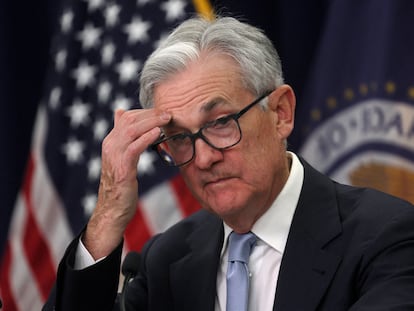Inflation pressures remain persistent as consumers pull back
Data issued Friday by the Labor Department showed that workers’ pay and benefits rose 1.2% in the first three months of this year

Key measures of prices and wages remained high in March, keeping the Federal Reserve on track to raise interest rates next week for the 10th time since March of last year in its drive to defeat high inflation.
An index that is closely followed by the Fed, which excludes volatile food and energy costs to capture “core” inflation, rose 0.3% from February to March and 4.6% from a year earlier, according to a report Friday from the Commerce Department. That is still far above the Fed’s 2% target rate. Some Fed officials are concerned that core inflation hasn’t declined much since reaching 4.7% in July.
And a separate measure issued Friday by the Labor Department showed that workers’ pay and benefits rose 1.2% in the first three months of this year, faster than the 1.1% rise in last year’s final quarter. While that trend is good for employees, Fed officials worry that companies will seek to offset their higher labor costs by further raising prices and perpetuating high inflation.
Paychecks grew 5.1% in the first quarter compared with a year ago, before adjusting for inflation, the Labor Department said, unchanged from three months earlier. The Fed regards wage increases above roughly 3.5% as too high for it to reach its 2% inflation target.
The latest inflation figures point to the dilemma confronting officials at the Federal Reserve: Across the economy, price increases for many goods have slowed significantly. And some previous drivers of inflation, notably clogged supply chains, have eased. Yet prices for many services, including restaurants, auto insurance and hotel rooms, are still surging, fueled by greater demand from consumers who in many cases have enjoyed rising wages.
Given the still-high levels of hiring and wage growth, economists expect the Fed to raise rates again next week and to keep them high through the end of the year. If, as expected, the Fed raises its benchmark rate next week by a quarter-point, it would reach 5.1%, the highest level in 17 years.
The Fed’s rate increases are intended to slow borrowing and spending, cool the economy and conquer high inflation. But in the process, the rate hikes typically lead to higher costs for many loans, from mortgages and auto purchases to credit cards and corporate borrowing and heighten the risk of a recession. Most economists foresee a recession this year as a consequence.
“We need job growth to slow much more quickly than it currently is,” said Ryan Sweet, chief U.S. economist at Oxford Economics, a consulting firm. “And until we start to see signs of that, I think the Fed is going to err on the side of doing too much.”
Faced with high prices and interest rates, consumers have begun reining in their spending. Consumer spending was flat in March for a second straight month, the government reported Friday. Americans sharply cut their spending on autos, furniture and appliances, while continuing to spend on services, including household utilities, restaurant meals and hotel visits.
Friday’s data did include some encouraging signs regarding inflation: Overall prices ticked up just 0.1% from February to March. That was the smallest monthly rise since last July and was down from a 0.3% increase from January to February. And compared with a year ago, inflation slowed to just 4.2%, though much of that decline reflected lower gas prices, which are particularly volatile. That is the lowest year-over-year overall inflation figure in nearly two years.
And some chronic drivers of inflation moderated last month. Rental costs grew 0.5% in March, down from 0.8% in February. Soaring rental costs have been a major contributor to higher inflation since the pandemic struck. Yet real-time data show rental costs declining as more apartments have been built, suggesting that housing price growth should continue to slow.
But many other services costs, which the Fed is also closely monitoring, remained high: Restaurant prices rose 0.6% last month. Hotel costs soared 3.1%. Child care costs jumped 1.4%.
The Fed prefers the inflation gauge that was issued Friday, called the personal consumption expenditures (PCE) price index, over the government’s better-known consumer price index. Typically, the PCE index shows a lower inflation level than CPI. In part, that’s because rents, which have been among the biggest drivers of inflation, carry twice the weight in the CPI that they do in the PCE.
The PCE price index also seeks to account for changes in how people shop when inflation jumps. As a result, it can capture emerging trends — when, for example, consumers shift away from pricey national brands in favor of less expensive store brands.
The index showed that food prices dropped 0.2% from February to March. Energy costs plummeted 3.7%, which partly reflected seasonal changes. Gas prices have since increased in many states.
On Thursday, the government reported that the economy expanded at just a 1.1% annual rate in the January-March quarter, much less than the 2.6% growth in the previous quarter, a sign the Fed’s hikes are starting to slow growth.
Analysts have expressed concern that last month’s collapse of two large banks is causing the banking industry as a whole to pull back on lending to shore up the industry’s financial health. Tighter credit standards could make it harder for businesses to borrow and expand, slowing the economy even further.
At the Fed’s meeting in March, its economic staff forecast that the U.S. economy would fall into a “mild recession” this year, in part because of the economic impact of the banking industry’s turmoil.
Sign up for our weekly newsletter to get more English-language news coverage from EL PAÍS USA Edition
Tu suscripción se está usando en otro dispositivo
¿Quieres añadir otro usuario a tu suscripción?
Si continúas leyendo en este dispositivo, no se podrá leer en el otro.
FlechaTu suscripción se está usando en otro dispositivo y solo puedes acceder a EL PAÍS desde un dispositivo a la vez.
Si quieres compartir tu cuenta, cambia tu suscripción a la modalidad Premium, así podrás añadir otro usuario. Cada uno accederá con su propia cuenta de email, lo que os permitirá personalizar vuestra experiencia en EL PAÍS.
¿Tienes una suscripción de empresa? Accede aquí para contratar más cuentas.
En el caso de no saber quién está usando tu cuenta, te recomendamos cambiar tu contraseña aquí.
Si decides continuar compartiendo tu cuenta, este mensaje se mostrará en tu dispositivo y en el de la otra persona que está usando tu cuenta de forma indefinida, afectando a tu experiencia de lectura. Puedes consultar aquí los términos y condiciones de la suscripción digital.
More information
Últimas noticias
From Andorra to Gibraltar, a black market for Ozempic exploits its success: ‘They’re the most sought-after products in the world’
The brief rise and retreat of Generation Z in Mexico
From safe-haven investment to geostrategic weapon: Who owns the most gold and where are the bars kept?
Todd Green, head of the company that created ‘Candy Crush’: ‘Success for us is that players want to play for years’
Most viewed
- Why we lost the habit of sleeping in two segments and how that changed our sense of time
- Charles Dubouloz, mountaineering star, retires at 36 with a farewell tour inspired by Walter Bonatti
- Venezuela faces its most tense Christmas yet
- CBS in crisis after pulling a report on Trump’s deportations to El Salvador (which later leaked online)
- Bukele clan fumes over investigation exposing their new wealth










































